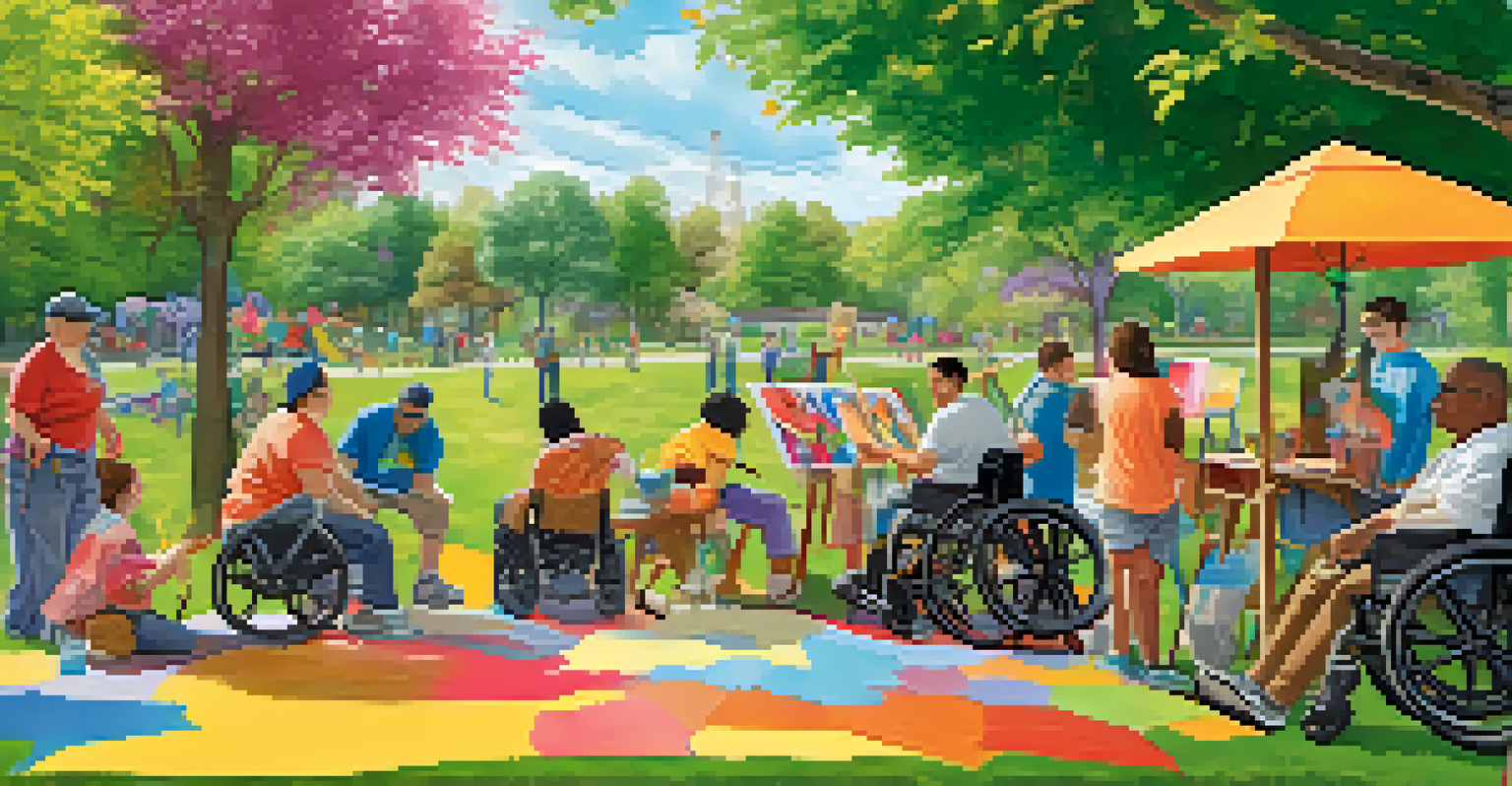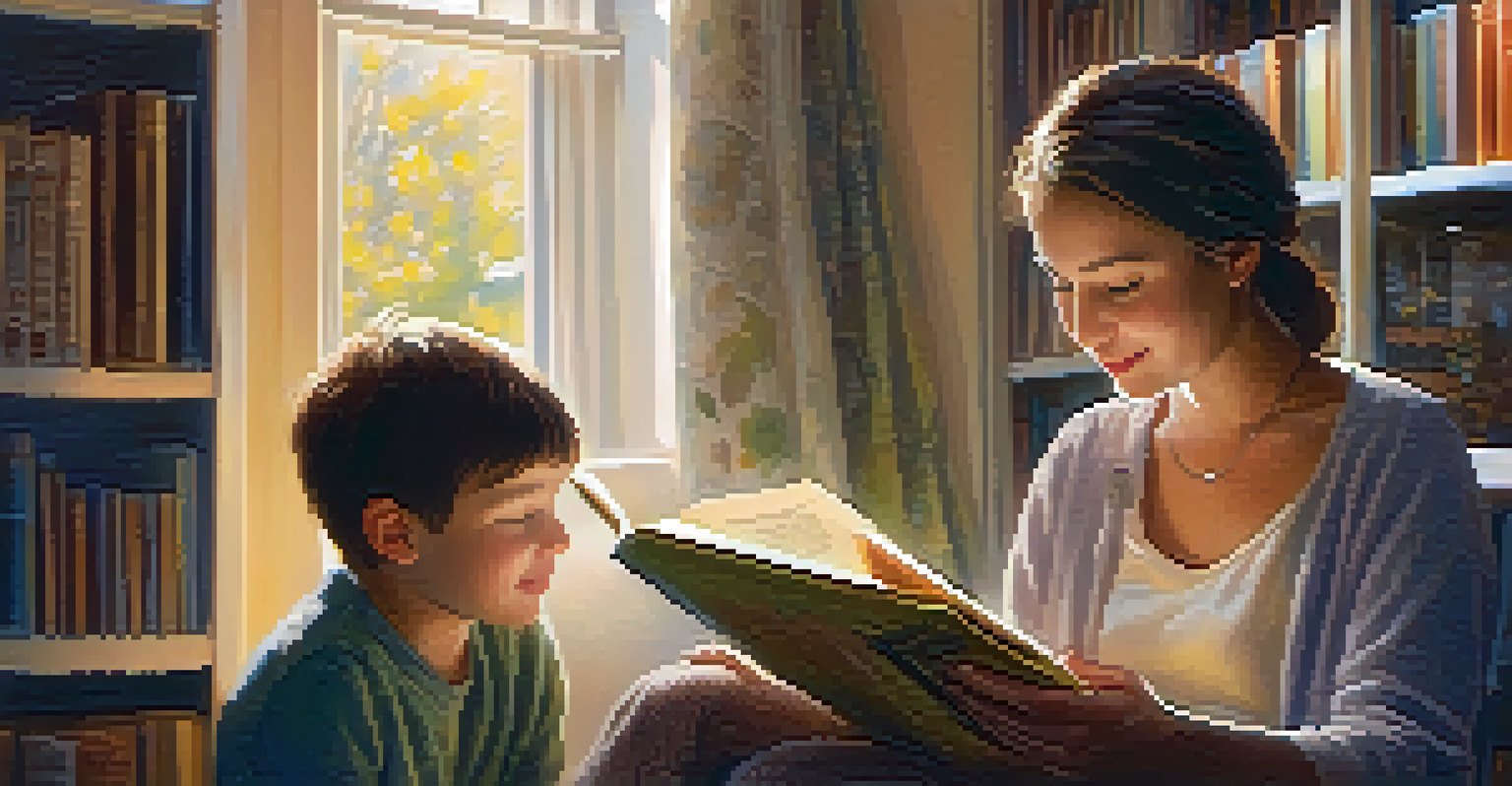Exploring Disability Narratives in Visual Storytelling

The Power of Visual Storytelling in Disability Narratives
Visual storytelling has the remarkable ability to convey complex emotions and experiences, allowing audiences to connect with narratives on a deeper level. Through images, videos, and illustrations, creators can share unique perspectives that might otherwise be overlooked. This is particularly vital in disability narratives, where traditional storytelling often fails to capture the full spectrum of experiences individuals face.
The stories we share can inspire, educate, and connect us in profound ways.
By using visual mediums, artists and filmmakers can create empathy, inviting viewers into the lives of people with disabilities. For instance, a documentary featuring a disabled athlete can highlight not just their challenges, but also their triumphs and passions. This multifaceted approach enriches the narrative, illustrating that disability is just one aspect of a person's identity.
Moreover, visual storytelling can challenge stereotypes and misconceptions about disability. By presenting authentic stories that celebrate diversity and resilience, creators can foster understanding and acceptance, paving the way for greater inclusion in society.
Understanding Disability Narratives: A Brief Overview
Disability narratives encompass the stories told by and about individuals with disabilities, offering insight into their lived experiences. These narratives can range from personal accounts to broader societal discussions, and they often seek to challenge the dominant narratives that marginalize disabled voices. The importance of these stories lies in their ability to educate, inspire, and promote awareness.

Historically, disability narratives have been shaped by societal perceptions, often reflecting a medical model that focuses on limitations. However, the shift towards a social model of disability emphasizes the barriers created by society, highlighting how these obstacles can be dismantled. This evolution in narrative perspective allows for a richer understanding of the disabled experience.
Visual Storytelling Fosters Empathy
Using images and videos, visual storytelling in disability narratives allows audiences to connect deeply with diverse experiences.
As we explore disability narratives in visual storytelling, it's essential to recognize the agency and creativity of disabled individuals themselves. By prioritizing their voices and stories, we can create a more authentic representation that resonates with diverse audiences.
Challenges in Representing Disability Visually
Despite the potential for impactful storytelling, there are significant challenges in representing disability visually. One major issue is the risk of perpetuating stereotypes or portraying individuals with disabilities in a one-dimensional manner. When creators rely on clichés or sensationalism, they undermine the complexity of real-life experiences.
Authenticity is crucial in disability storytelling, as it fosters trust and connection between the creator and the audience.
Another challenge is accessibility within visual storytelling itself. Creators must consider how to make their work inclusive for individuals with various disabilities, such as incorporating audio descriptions or captions. This not only broadens the audience but also ensures that disabled individuals can engage fully with the narrative.
Furthermore, there's often a lack of representation behind the camera, with many visual storytellers lacking firsthand experience with disability. This can lead to the misrepresentation of disabled lives, emphasizing the importance of involving disabled creatives in the storytelling process. Their insights can provide authenticity and nuance that enrich the narrative.
The Role of Authenticity in Disability Storytelling
Authenticity is crucial in disability storytelling, as it fosters trust and connection between the creator and the audience. When stories are told from genuine experiences, they resonate more powerfully, allowing viewers to empathize with the characters' journeys. Audiences are drawn to authenticity, as it reflects the real struggles and joys of life.
To achieve authenticity, creators should prioritize collaboration with disabled individuals throughout the storytelling process. This includes gathering personal stories, involving them in scripting, and ensuring their perspectives shape the final narrative. When disabled voices are at the forefront, the resulting work is richer and more nuanced.
Authenticity Enhances Representation
Prioritizing disabled voices in storytelling ensures genuine experiences are highlighted, fostering trust and understanding.
Additionally, authenticity challenges the notion of a 'singular' disabled experience. By showcasing diverse narratives, creators can illustrate the array of lived experiences within the disabled community, emphasizing that no two stories are alike. This representation fosters a deeper understanding among audiences and encourages inclusivity.
Case Studies: Successful Disability Narratives in Visual Media
Numerous successful examples of disability narratives in visual media showcase the potential for impactful storytelling. One notable case is the film 'The Theory of Everything,' which chronicles the life of physicist Stephen Hawking, exploring not only his challenges with ALS but also his remarkable achievements. This film humanizes disability, inviting audiences to see the person beyond the condition.
Another powerful example is the animated series 'Big Mouth,' which features a character with a disability navigating adolescence. By incorporating humor and relatable scenarios, the show effectively addresses the complexities of disability in a way that resonates with a broad audience. This blend of entertainment and education creates a space for important conversations about acceptance and understanding.
These case studies highlight the range of approaches to disability narratives, from serious biographical films to lighthearted animations. Each example underscores the importance of representation and authenticity, illustrating how diverse narratives can enrich our understanding of the disabled experience.
Future Directions in Disability Narratives and Visual Storytelling
As society continues to evolve, so too does the landscape of disability narratives in visual storytelling. Emerging technologies, such as virtual reality and interactive media, present new opportunities for creators to engage audiences in immersive experiences. These innovations can provide deeper insights into the lived experiences of individuals with disabilities, creating a more profound connection.
Furthermore, there is a growing demand for diverse representation in media, with audiences increasingly seeking authentic stories that reflect a variety of experiences. This shift is encouraging more disabled creators to share their narratives and perspectives, enriching the storytelling landscape. As more voices join the conversation, audiences can expect to see a wider range of stories that challenge stereotypes and promote understanding.
Future Needs Diverse Narratives
Emerging technologies and a demand for inclusivity are paving the way for more authentic and varied disability narratives.
Finally, the continued advocacy for inclusivity in the industry remains paramount. By supporting disabled storytellers and ensuring accessibility in visual media, we can work towards a future where disability narratives are celebrated and embraced. This will not only enhance the richness of storytelling but also foster a more inclusive society.
Conclusion: The Importance of Disability Narratives
In conclusion, exploring disability narratives in visual storytelling is vital for fostering understanding, empathy, and inclusivity. Through authentic representation and diverse perspectives, creators have the power to challenge stereotypes and reshape societal perceptions of disability. The stories we share can inspire, educate, and connect us in profound ways.
As we continue to advocate for greater representation in visual media, it's essential to uplift the voices of disabled individuals and prioritize their stories. By doing so, we enrich the narrative landscape and create a more equitable space for all storytellers. The future of disability narratives is bright, filled with possibilities for innovation and connection.

Ultimately, the power of storytelling lies in its ability to bridge gaps between experiences, fostering a sense of community and understanding. By embracing disability narratives, we can create a richer, more inclusive world that celebrates the diversity of human experience.